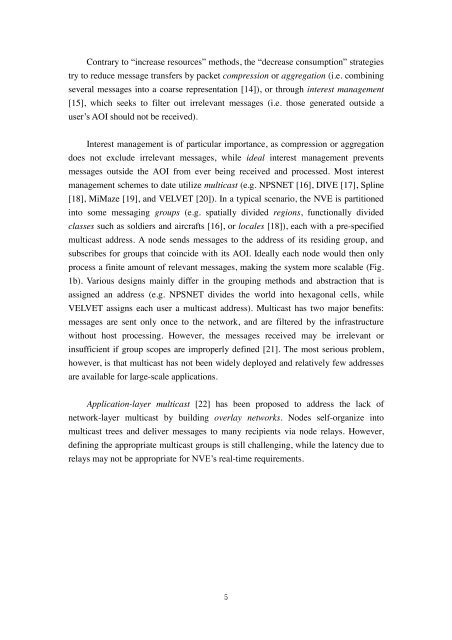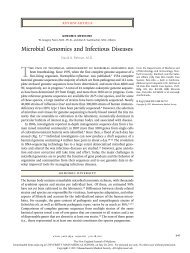A Scalable Peer-to-Peer Network for Virtual Environments - Evernote
A Scalable Peer-to-Peer Network for Virtual Environments - Evernote
A Scalable Peer-to-Peer Network for Virtual Environments - Evernote
Create successful ePaper yourself
Turn your PDF publications into a flip-book with our unique Google optimized e-Paper software.
Contrary <strong>to</strong> 5increase resources6 methods, the 5decrease consumption6 strategies<br />
try <strong>to</strong> reduce message transfers by packet compression or aggregation (i.e. combining<br />
several messages in<strong>to</strong> a coarse representation [14]), or through interest management<br />
[15], which seeks <strong>to</strong> filter out irrelevant messages (i.e. those generated outside a<br />
/*78)*+AOI should not be received).<br />
Interest management is of particular importance, as compression or aggregation<br />
does not exclude irrelevant messages, while ideal interest management prevents<br />
messages outside the AOI from ever being received and processed. Most interest<br />
management schemes <strong>to</strong> date utilize multicast (e.g. NPSNET [16], DIVE [17], Spline<br />
[18], MiMaze [19], and VELVET [20]). In a typical scenario, the NVE is partitioned<br />
in<strong>to</strong> some messaging groups (e.g. spatially divided regions, functionally divided<br />
classes such as soldiers and aircrafts [16], or locales [18]), each with a pre-specified<br />
multicast address. A node sends messages <strong>to</strong> the address of its residing group, and<br />
subscribes <strong>for</strong> groups that coincide with its AOI. Ideally each node would then only<br />
process a finite amount of relevant messages, making the system more scalable (Fig.<br />
1b). Various designs mainly differ in the grouping methods and abstraction that is<br />
assigned an address (e.g. NPSNET divides the world in<strong>to</strong> hexagonal cells, while<br />
VELVET assigns each user a multicast address). Multicast has two major benefits:<br />
messages are sent only once <strong>to</strong> the network, and are filtered by the infrastructure<br />
without host processing. However, the messages received may be irrelevant or<br />
insufficient if group scopes are improperly defined [21]. The most serious problem,<br />
however, is that multicast has not been widely deployed and relatively few addresses<br />
are available <strong>for</strong> large-scale applications.<br />
Application-layer multicast [22] has been proposed <strong>to</strong> address the lack of<br />
network-layer multicast by building overlay networks. Nodes self-organize in<strong>to</strong><br />
multicast trees and deliver messages <strong>to</strong> many recipients via node relays. However,<br />
defining the appropriate multicast groups is still challenging, while the latency due <strong>to</strong><br />
relays may not be appropriate+1%8+429)* real-time requirements.<br />
%
















